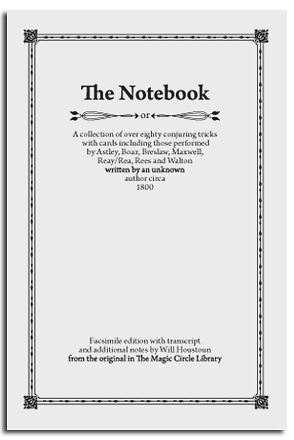The Notebook by Anonymous
Reviewed by Jamy Ian Swiss (originally published in Genii May, 2009)

Will Houstoun is a member of The Magic Circle who, on one of his many forays into the Circle's excellent research library, came upon a small book labeled "Card Tricks," that was in fact a bound, handwritten notebook of card magic penned by an unknown magician, around the latter part of the 18th century. Mr. Houstoun's curiosity was aroused, to say the least, and the result is this marvelous volume, dubbed simply, The Notebook.
The original notebook is a handwritten manuscript which describes 81 card tricks. The unknown author was an enthusiastic and dedicated reporter who saw many of the leading magicians of his era, read the books of the era, paid attention to the details of his own performing experience as well as the performance of others, and carefully recorded those details with a level of care that is startling for his time, demonstrating a degree of sophistication that shows flashes of what we would consider a thoroughly modern conjuring mindset.
This smartly if simply produced volume consists of a complete facsimile of the original pages, provided on the left side of the text, accompanied by an exact transcription typeset on the right, along with accompanying footnotes and references amassed by Mr. Houstoun. He also provides a number of addenda, including biographies of all the magicians the original scribe mentions; our intrepid reporter actually witnessed performances by Philip Breslaw, the likely author of Breslaw's Last Legacy, released in 1784. Mr. Houstoun researches another ten names mentioned by the original reporter, providing biographies to the extent that available resources can furnish. Mr. Houstoun also offers several pages of analysis of his attempts to date the manuscript, based on various citations within of books read, performers seen, language conventions, and the like to explain and substantiate his conclusion that the notebook was likely written between 1792 and 1806.
As such, it is a remarkable and at times astonishing document. The writer was a careful thinker and recorder, and you can see by his revisions that he made every attempt to write clear and cogent descriptions that would be useful to the reader. He also provides bits of advice and finesse about timing and psychology that seem based on personal experience and insight. In these pages are unmistakable descriptions of the Double-Lift; the Classic Force and "outs"; the Top Change; psychological "think of a card" forces; the "General Card" plot; even a nod to what Erdnase would later call "uniformity of action" (in this case, setting up the action of a later force by using a similar manner of handling); and a first-rate two-card transposition using a duplicate card, and staged (not unlike John Scarne's iconic use of a stemmed glass) using a spectator's upturned hand, with one card beneath the hand and the other on its palm.
The entire project is a treat an inexpensive adventure in time travel for any reader with some imagination and a passion for card magic and, perhaps, an interest in its history. Climbing into its pages, we get to spend some time enjoying our shared passion with another enthusiast, who, far more like us than different, happened to be doing his tricks a couple of hundred years ago. If that isn't magic, I don't know what is.
